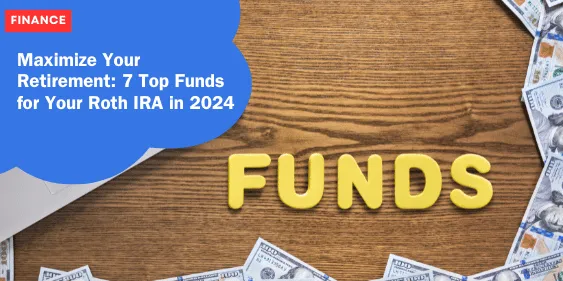Maximize Your Retirement: 7 Top Funds for Your Roth IRA in 2024

Definition and Benefits of Roth IRAs
A Roth IRA, or Roth Individual Retirement Account, is a type of retirement savings account that allows you to withdraw your savings tax-free in retirement.
Contributions are made with after-tax dollars, meaning you don’t get a tax deduction for the contributions you make.
However, the major benefit comes later: all the money you withdraw in retirement, including the earnings on your investments, is tax-free.
Tax Advantages and Eligibility Requirements
Roth IRAs provide a significant tax advantage by enabling your investments to grow tax-free.
This means that any income, dividends, or capital gains realized within the account aren’t subject to taxes.
Additionally, withdrawals after age 59½ are tax-free if the account has been open for at least five years.
This is a stark contrast to traditional IRAs, where withdrawals are taxed as ordinary income.
To contribute to a Roth IRA, your modified adjusted gross income must be below certain thresholds.
For 2024, the limit is $146,000 for single filers and $230,000 for joint filers to be able to contribute the full amount.
You can contribute up to $7,000 annually, with an additional $1,000 allowed as a catch-up contribution if you are 50 or older.
Importance of Fund Selection for Roth IRAs
Choosing the right funds for your Roth IRA is crucial to maximize its benefits.
Since the Roth IRA already optimizes for tax-free growth, selecting funds that otherwise generate taxable income can offer significant advantages.
For example, dividend-paying stocks, REITs, and high-yield bond funds are excellent candidates due to their typically higher tax inefficiency.
Additionally, diversification is critical. A well-rounded mix of conservative income funds, growth-oriented funds, and index funds can provide a balance between risk and reward while maximizing long-term returns.
Proper fund selection can also help to align with your individual financial goals and risk tolerance.
Understanding the tax implications and growth potential of different funds will position you to make the most out of your Roth IRA, setting a solid foundation for a secure retirement.
Conservative Income Funds
Vanguard Wellesley Income Fund Investor Shares (VWINX)
When it comes to conservative income strategies for your Roth IRA, the Vanguard Wellesley Income Fund Investor Shares (VWINX) stands out. Known for its balanced mix of around 60% bonds and 40% stocks, this fund aims to provide a consistent income stream while maintaining a relatively low-risk profile.
As of the recent period, VWINX offers a 3.8% 30-day SEC yield and has delivered an annualized total return of 5% over the past decade, making it a reliable choice for conservative investors.
Importantly, the fund’s quarterly returns adjust to 3.3% after taxes, which illustrates its suitability for tax-advantaged accounts like Roth IRAs.
Benefits of Conservative Strategies in Roth IRAs
A conservative strategy can be particularly advantageous in a Roth IRA because it aligns with long-term, tax-free growth.
While high-income generation is essential, keeping risks low ensures that your retirement savings remain stable.
By investing in conservative funds like VWINX within your Roth IRA, you can take full advantage of its tax-free compounding benefits.
Given that income from bonds and dividends can otherwise be tax-inefficient, placing such assets in a Roth IRA offers a significant tax shield.
Balancing Income Generation with Tax Efficiency
Balancing income generation with tax efficiency is crucial for maximizing the benefits of your Roth IRA. VWINX is an excellent example of a fund that fits well into this strategy.
By housing VWINX in a Roth IRA, you can avoid the tax drag typically associated with its income distributions and instead enjoy the full benefits of its returns.
As noted by financial advisors, it’s generally better to allocate less tax-efficient assets like taxable bonds or actively managed funds in a Roth IRA, thus optimizing the overall after-tax returns.
While a conservative fund like VWINX forms the backbone of a stable Roth IRA portfolio, other types of investments can add further growth and diversification potential.
Index Fund Options
Vanguard 500 Index Fund Admiral Shares (VFIAX)
When it comes to low-cost index funds, the Vanguard 500 Index Fund Admiral Shares (VFIAX) stands out as a prime option for your Roth IRA.
This fund mirrors the performance of the S&P 500, which represents the 500 largest publicly traded companies in the U.S.
By tracking this benchmark, VFIAX offers diversified exposure to some of the most well-known and stable companies, including industry giants like Apple, Microsoft, and Amazon.
Advantages of Low-Cost Index Funds in Roth IRAs
One of the standout features of VFIAX is its remarkably low expense ratio of just 0.04%, making it a cost-efficient choice compared to many actively managed funds.
Keeping expenses low is crucial in a Roth IRA because every dollar saved on fees can compound tax-free over time, significantly boosting your retirement savings.
Additionally, index funds like VFIAX are inherently tax-efficient. Given that a low turnover rate minimizes taxable events, the tax-free growth advantage offered by Roth IRAs can be maximized when holding index funds.
Despite being tax-efficient, holding VFIAX in a Roth IRA can still offer benefits due to the complete elimination of taxes on capital gains and dividends, a perk you wouldn’t get in a taxable account.
Long-Term Growth Potential of S&P 500 Tracking Funds
Historical performance data backs up the robust long-term growth potential of S&P 500 index funds like VFIAX.
Over the past decade, VFIAX has delivered an annualized return of approximately 12.8%.
While past performance is not a guarantee of future results, this consistent track record of growth speaks volumes about the stability and potential of an investment in VFIAX.
Particularly for younger investors with a long time horizon, the compounding effect of VFIAX can be profound.
The absence of taxes on growth means your investments can compound faster, leading to a more substantial retirement nest egg.
Even though there’s a $3,000 minimum investment for VFIAX, Vanguard offers an equivalent exchange-traded fund (ETF) called Vanguard S&P 500 ETF (VOO), which trades for around $515 per share and charges a slightly lower expense ratio of 0.03%.
Transitioning from the benefits of index funds, let’s now delve into another compelling investment option for Roth IRAs that focuses on growth.
Growth-Oriented Funds
When it comes to younger investors, a growth-oriented fund can be a game-changer, especially when it’s housed in a Roth IRA.
One such exemplary fund is the Fidelity Contrafund (FCNTX).
This fund focuses on large-cap growth stocks and has a long-standing reputation for delivering impressive returns.
Fidelity Contrafund (FCNTX)
FCNTX has been in operation since 1967. Initially relying on a contrarian investment strategy, it shifted to a large-cap growth approach under the management of William Danoff in 1990.
Over the last decade, FCNTX has generated an annualized return of 14.9%, outperforming the S&P 500, which averaged about 13% during the same period.
Such superior performance can be substantially beneficial for younger investors who have time on their side to let their investments grow.
Benefits of Growth-Focused Funds for Younger Investors
Investing in growth-focused funds like FCNTX allows younger investors to capitalize on higher potential returns.
With more years before retirement, they can withstand short-term volatility in exchange for long-term gains.
Importantly, holding these investments in a Roth IRA minimizes tax burdens, allowing the full power of compounding to work for them.
Leveraging Tax-Free Growth in Roth IRAs
One of the key advantages of a Roth IRA is its tax-free growth.
Investors who own FCNTX within a Roth IRA won’t have to pay taxes on dividends or capital gains.
Over time, this can translate into significant savings and more wealth accumulation.
For example, the potential loss in compounding due to taxes is entirely avoided, maximizing your retirement nest egg.
As we continue to explore different investment strategies to optimize your Roth IRA, understanding the value of growth-oriented funds can set a strong foundation for long-term financial success.
Real Estate Investment Trusts (REITs)
Cohen & Steers Quality Income Realty Fund (RQI)
When it comes to including real estate in your Roth IRA, the Cohen & Steers Quality Income Realty Fund (RQI) is a compelling choice.
This closed-end fund provides exposure to a diversified portfolio of high-quality real estate investments, leveraging its asset base to enhance income and potential returns.
With a high yield of 5.9% and trading at a slight discount to its net asset value (NAV), RQI offers significant income opportunities.
Advantages of REITs in Tax-Advantaged Accounts
REITs are particularly beneficial in tax-advantaged accounts like Roth IRAs due to their structure.
They are required to distribute most of their profits as dividends, which are typically taxed as ordinary income.
However, housing these income-producing assets within a Roth IRA allows you to bypass the usual tax hit, ensuring you retain more of your investment gains.
- Dividend Payouts: REITs generally offer higher dividend yields than traditional stocks, making them an excellent choice for those seeking consistent income.
- Tax Efficiency: Within a Roth IRA, the normally cumbersome tax on REIT income is eliminated, making every dollar it generates more impactful for your retirement fund.
- Diversification: Including REITs in your investment mix can provide portfolio diversification, reducing overall risk by spreading investments across various sectors of the real estate market.
Potential for High Income and Capital Appreciation
Investing in REITs like RQI not only offers high income but also the potential for capital appreciation.
As the real estate market grows, the value of the underlying properties can increase, boosting the fund’s NAV and, consequently, the value of your shares.
This dual benefit of income and potential price appreciation makes REITs a powerful tool for long-term growth in a Roth IRA.
- Leverage: RQI employs leverage, currently at 27.4%, to amplify both returns and income potential. While this introduces higher volatility and interest expenses, the net effect can be more substantial gains for investors over time.
- Market Opportunity: Real estate markets often perform differently compared to the equity markets, offering a counterbalance during stock market downturns. This characteristic ensures that your investment grows in different economic environments.
REITs, particularly those like the Cohen & Steers Quality Income Realty Fund, stand out as a strategic addition to any Roth IRA.
Their inherent tax advantages, combined with substantial income and appreciation potential, make them a valuable component of a diversified retirement portfolio.
Value and Small-Cap Funds
Avantis All Equity Markets Value ETF (AVGV)
When it comes to achieving long-term growth in a Roth IRA, diversification is key.
The Avantis All Equity Markets Value ETF (AVGV) offers a fantastic way to attain this through broad exposure to value and small-cap stocks.
The AVGV ETF is essentially a “fund of funds,” holding six other Avantis ETFs that diversify across different segments, including U.S. large-cap value, international large-cap value, U.S. small-cap value, emerging market value, international small-cap value, and U.S. mid-cap value stocks.
This unique structure offers a comprehensive approach to capturing value across various market segments at a relatively low expense ratio of 0.26%, which includes all underlying fund fees.
Benefits of Diversification Across Value and Small-Cap Stocks
Diversifying your investments across value and small-cap stocks can provide several benefits, particularly in a Roth IRA. These stocks often come with a high discount rate embedded in their market price, which generally drives higher expected returns. According to Ted Randall, a senior portfolio manager at Avantis Investors, targeting these investments can offer a shot at outperforming the market. The rationale is that smaller and value-oriented companies, which may be underpriced or overlooked, have a higher probability of providing significant returns when they hit their growth stride.
Potential for Outperformance in Roth IRAs
Holding value and small-cap stocks in a Roth IRA can amplify the tax benefits. Since Roth IRAs allow for tax-free growth, the potential for these stocks to outperform means you can reap the rewards without worrying about capital gains taxes. Over time, the compounding of these high returns can significantly bolster your retirement savings. Whether you prefer domestic or international exposure, AVGV’s diversified portfolio can help you maximize these opportunities while mitigating risk.
The future holds numerous investment avenues; it’s crucial to keep exploring diverse strategies to maximize your Roth IRA’s benefits.
Alternative Investments
Grayscale Bitcoin Mini Trust (BTC)
Cryptocurrencies, particularly Bitcoin, have become increasingly popular as an alternative investment for Roth IRAs. One notable option is the Grayscale Bitcoin Mini Trust (BTC), which allows investors to gain exposure to Bitcoin in a tax-advantaged manner.
Diversification Benefits of Cryptocurrencies
Adding cryptocurrencies like Bitcoin to your Roth IRA can significantly enhance your portfolio’s diversification. Traditional assets such as stocks and bonds often correlate with each other, but cryptocurrencies tend to move independently. This lack of correlation can provide a hedge against market volatility and economic downturns. According to Chris Kline, co-founder of Bitcoin IRA, Roth IRAs enable Americans to invest in high-growth assets like Bitcoin while maximizing future tax savings.
Considerations for High-Growth, High-Risk Assets in Roth IRAs
Investing in high-growth, high-risk assets such as Bitcoin presents unique opportunities and challenges:
- Potential for High Returns: Bitcoin has shown substantial growth in the past decade, often outperforming traditional asset classes. In a Roth IRA, the gains from such high-growth investments will be tax-free, enhancing your retirement nest egg.
- Volatility: Bitcoin’s price can be extremely volatile, swinging dramatically in short periods. This characteristic makes it a high-risk asset, unsuitable for those with low risk tolerance.
- Regulation and Security: The regulatory landscape for cryptocurrencies is still developing, and security risks like hacking attacks remain a concern. When investing in Bitcoin through Grayscale Bitcoin Mini Trust, it is essential to consider these factors and stay informed about regulatory changes.
Fees and Expenses
The Grayscale Bitcoin Mini Trust (BTC) offers a lower cost structure than its predecessor, the Grayscale Bitcoin Trust (GBTC). BTC charges a 0.15% sponsor fee, making it more economical for long-term, buy-and-hold strategies compared to GBTC’s more substantial 1.5% expense ratio.
Final Thoughts
Integrating Bitcoin into a Roth IRA could provide substantial growth benefits and portfolio diversification, although it requires careful consideration due to its high-risk nature.rospection. As we delve deeper into our next topic, it’s crucial to assess whether cryptocurrencies like Bitcoin align with your overall investment strategy and risk tolerance.
Income-Focused ETFs
Amplify CWP Enhanced Dividend Income ETF (DIVO)
Dividend-focused strategies can be highly effective in Roth IRAs, and the Amplify CWP Enhanced Dividend Income ETF (DIVO) is a prime example of this. DIVO focuses on high-quality, large-cap stocks with consistently growing earnings and cash flow. According to Christian Magoon, CEO of Amplify ETFs, the fund adds an attractive layer of income potential through its rules-based active strategy, which includes tactical covered call writing. This technique becomes particularly useful when market volatility increases, effectively boosting the ETF’s income potential.
DIVO is well-regarded for its strong risk-adjusted returns and holds a five-star rating from Morningstar in the “derivative income” fund peer category. Currently, it offers a 4.8% annualized distribution yield, which makes it an appealing choice for those seeking steady income. Unlike many other covered call ETFs, DIVO conducts call writing on individual holdings. This method caps the upside less, resulting in superior total returns and making it a robust option for those aiming for balanced growth and income.
Benefits of Dividend-Focused Strategies in Roth IRAs
Housing dividend-focused ETFS like DIVO in a Roth IRA can maximize long-term income potential while benefitting from the tax-free growth environment these accounts offer. Investments that generate high dividend income can lead to ongoing tax liabilities in regular accounts, but within a Roth IRA, these dividends can accumulate and grow without the drag of taxes.
This tax efficiency allows dividend-focused funds to operate at their full potential, compounding the returns over time. Given that Roth IRAs don’t impose required minimum distributions (RMDs), investors can let their investments grow uninterrupted, making DIVO an ideal candidate for this type of retirement account.
Tactical Covered Call Writing for Enhanced Income
A notable feature of DIVO is its use of tactical covered call writing. This strategy involves selling call options on individual stock holdings to generate additional income. When volatility in the market is high, the premiums earned from selling calls can be substantial, enhancing the ETF’s income significantly.
By utilizing covered call writing, DIVO offers a way to mitigate some market risks while still capitalizing on income opportunities. This makes it a practical choice for investors who want to balance income generation with growth potential, leveraging the tax advantages of Roth IRAs to their fullest extent.
With these attributes, DIVO exemplifies how targeted investment strategies within Roth IRAs can lead to enhanced, tax-efficient income, making retirement planning both effective and fiscally smart.
As we move on to explore other fund options, remember that the balance between income generation and potential for long-term growth is crucial for making the most out of your Roth IRA.
Growth and Income Combination
Amplify CWP Growth & Income ETF (QDVO)
When it comes to blending growth potential with income generation, the Amplify CWP Growth & Income ETF (QDVO) offers an innovative solution.
QDVO builds on the success of its predecessor, the DIVO ETF, by focusing on large-cap growth stocks, which means it’s packed with some of the most high-potential tech giants and other substantial firms.
This ETF is designed for investors seeking capital appreciation but with an added layer of income, thanks to its tactical investment strategies.
Balancing Growth Potential with Income Generation
QDVO skillfully combines growth and income through a strategic selection of stocks and tactical covered call options.
Its top holdings feature formidable names like Nvidia Corp., Microsoft Corp., Apple Inc., Amazon.com Inc., Alphabet Inc., Meta Platforms Inc., and Tesla Inc.
These companies have shown significant growth in their sectors and offer strong prospects for future gains.
To balance growth with income, QDVO employs a covered call writing strategy on individual stock holdings.
This approach helps generate monthly income while potentially capping some of the upside in price return.
The covered call strategy is beneficial in a volatile market, providing additional income without entirely sacrificing growth opportunities.
Leveraging Large-Cap Growth Stocks in Roth IRAs
Housing QDVO in a Roth IRA allows investors to maximize the benefits of tax-free growth and income.
Given Roth IRA’s structure, the income and capital gains generated by QDVO are not subject to taxes, enhancing the overall return on investment.
For investors who prioritize long-term growth but also desire regular income, QDVO offers a compelling mix.
The strategy of embedding high-growth large-cap stocks within QDVO aligns well with the Roth IRA’s advantages.
Companies like those in QDVO’s portfolio typically reinvest profits to fuel expansion and innovation, promising substantial capital appreciation over time.
Meanwhile, the tactical income strategy brings in regular income, making it a perfect fit for both growth-oriented and income-dependent investors.
Investing in QDVO within a Roth IRA means you can grow your wealth without worrying about the tax implications typically associated with high-income and growth assets.
This dual benefit reinforces the Roth IRA’s role as a powerful retirement tool, combining the best of both growth and income generation.
The dynamic combination of growth-centric stocks and a covered call strategy makes QDVO a robust choice for Roth IRAs, balancing portfolio growth while generating consistent income.
Conclusion and Recommendations
Importance of Diversification in Roth IRA Fund Selection
When it comes to managing a Roth IRA, diversification is the cornerstone of a successful long-term strategy.
Diversifying your investments across various types of funds helps mitigate risk and enhances the potential for overall returns.
By allocating your assets wisely among conservative income funds, index funds, growth-oriented funds, REITs, value and small-cap funds, alternative investments, and income-focused ETFs, you can better withstand market fluctuations.
Think of diversification as not putting all your eggs in one basket. This approach ensures that if one investment performs poorly, others may perform well, balancing your overall returns.
Considerations for Individual Investor Goals and Risk Tolerance
Every investor’s journey is unique, and your Roth IRA should reflect your personal financial goals and risk tolerance.
Are you a young investor with a long time horizon? You might benefit from growth-oriented funds like the Fidelity Contrafund (FCNTX) which leverage tax-free growth.
If you’re nearing retirement, perhaps a more conservative strategy with a focus on income generation and capital preservation might be your preference. Funds like the Vanguard Wellesley Income Fund (VWINX) can offer this balance.
Additionally, always consider the tax efficiency of the funds you choose. Investments that generate significant taxable income or capital gains, such as REITs, should be held in a Roth IRA to maximize tax-free growth benefits.
Regular Review and Rebalancing of Roth IRA Investments
Achieving the right balance isn’t a one-time effort. Market conditions and your financial situation change over time, making regular reviews and rebalancing of your Roth IRA crucial.
This means periodically assessing how your investments are performing and making necessary adjustments to keep your portfolio aligned with your goals.
Perhaps your high-growth assets have outperformed and now constitute a larger portion of your portfolio; you might want to sell some and reinvest in more conservative or diversified options.
Regular rebalancing helps maintain your desired asset allocation, keeping your investment strategy on track.
In conclusion, a well-diversified Roth IRA that aligns with your financial goals and risk tolerance can set you up for a secure retirement.
Regular reviews and adjustments ensure your investments continue to meet your evolving needs.






